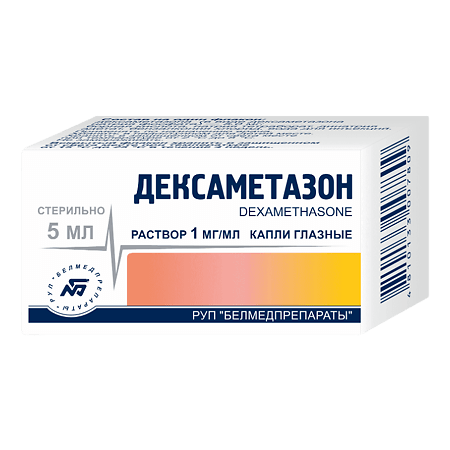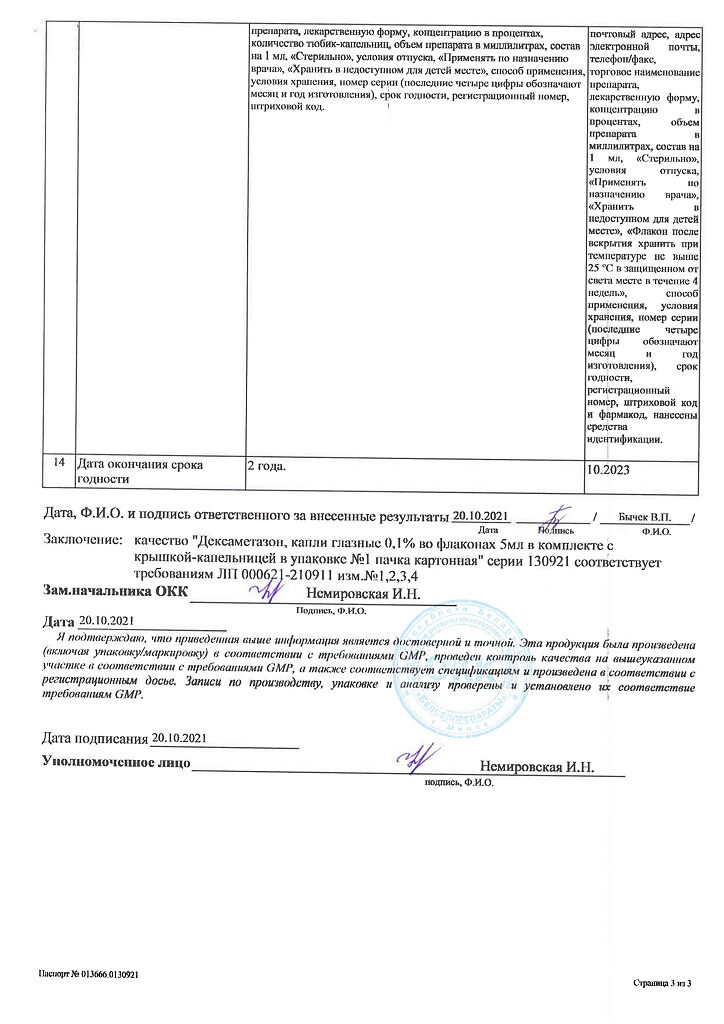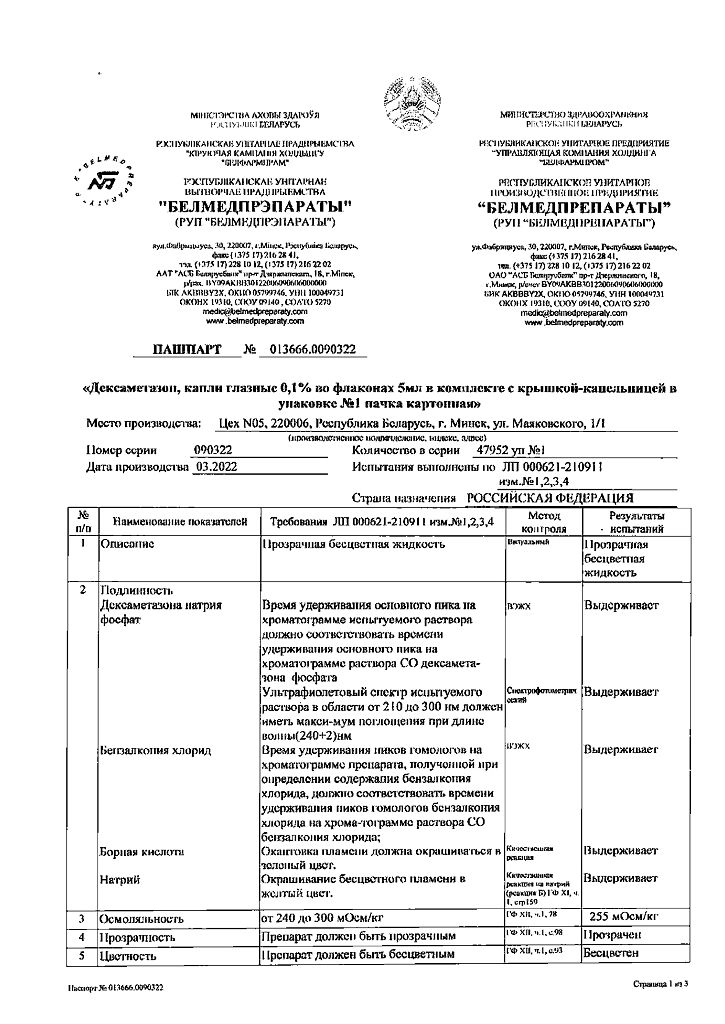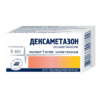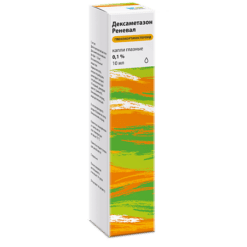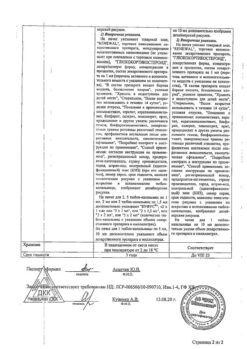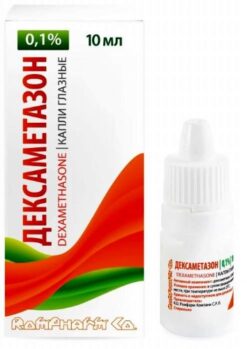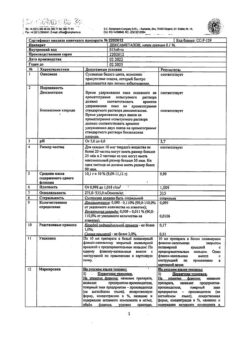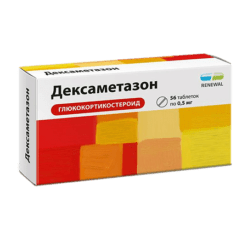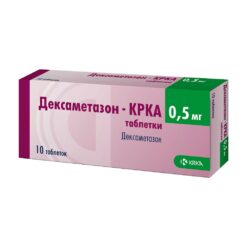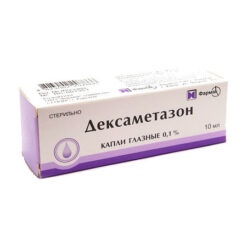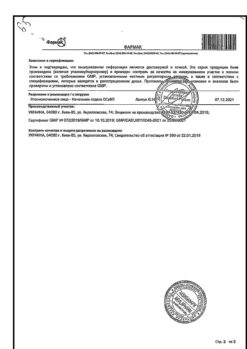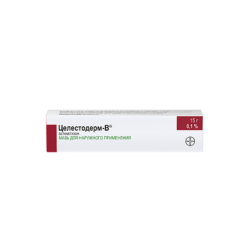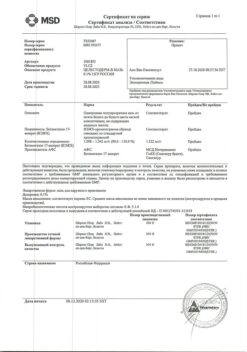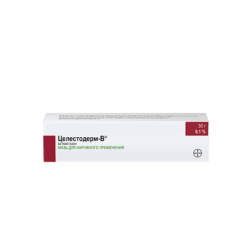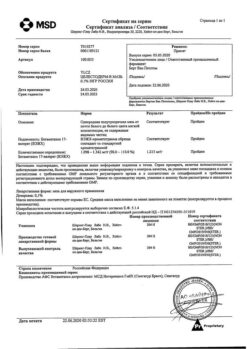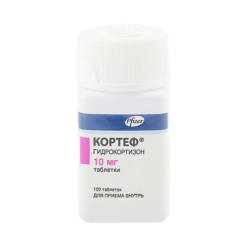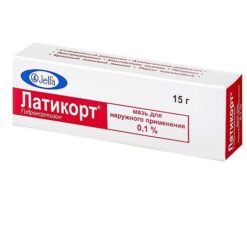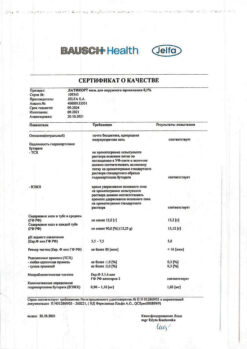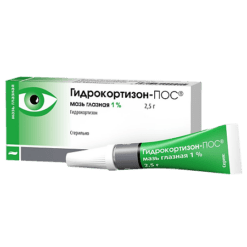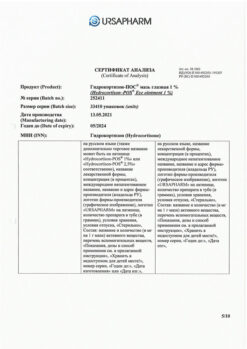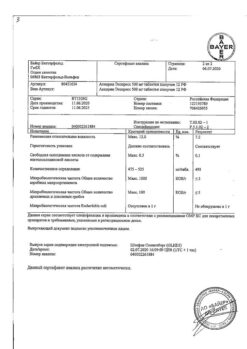No products in the cart.
Dexamethasone, eye drops 0.1% 5 ml
€4.52 €4.01
Description
It interacts with specific cytoplasmic receptors and forms a complex that penetrates into the cell nucleus and stimulates mRNA synthesis; the latter induces formation of proteins mediating cellular effects, including lipokortin, which inhibits phospholipase A2, inhibits arachidonic acid liberation and inhibits biosynthesis of endoperoxides, prostaglandins, leukotrienes that contribute to inflammation and allergy processes.
Dexamethasone inhibits the expression of genes of proteins involved in the development of inflammatory reactions. Prevents the release of inflammatory mediators from eosinophils and mast cells. Inhibits the activity of hyaluronidase, collagenase and proteases. Inhibits the activity of fibroblasts and collagen formation. Reduces capillary permeability, stabilizes cell membranes including lysosomal membranes, inhibits cytokine release from lymphocytes and macrophages.
Pharmacokinetics
Dexamethasone penetrates through the intact corneal epithelium into the moisture of the anterior chamber of the eye. If the mucous membrane is inflamed or damaged, the rate of penetration increases.
Systemic absorption is low, about 60-80% of dexamethasone entering the systemic bloodstream is bound to the specific carrier protein transcoritin and albumin, and bound dexamethasone has no biological activity. It easily passes through histohematic barriers, including the blood-brain barrier and the placental barrier.
Dexamethasone is metabolized in the liver under the action of cytochrome-containing enzymes and is excreted by the kidneys. The elimination half-life is on average 3 hours.
Indications
Indications
Allergic and inflammatory eye diseases: non-purulent and allergic conjunctivitis, keratitis, keratoconjunctivitis without damage to the epithelium, iritis, iridocyclitis, blepharoconjunctivitis, blepharitis, episcleritis, scleritis, inflammatory process after eye injuries and surgical interventions, sympathetic ophthalmia; macular edema due to occlusion of the central retinal vein or its branches, visual impairment due to diabetic macular edema in patients with pseudophakia, in patients who have an insufficient response to therapy, or those who are not suitable for therapy with drugs other than corticosteroids, inflammation of the choroid of the posterior part of the eye, which is non-infectious uveitis.
Pharmacological effect
Pharmacological effect
Pharmacotherapeutic group: Glucocorticosteroid for local use
Pharmacological action
GCS. Suppresses the functions of leukocytes and tissue macrophages. Limits the migration of leukocytes to the area of inflammation. It disrupts the ability of macrophages to phagocytose, as well as to form interleukin-1. Helps stabilize lysosomal membranes, thereby reducing the concentration of proteolytic enzymes in the area of inflammation. Reduces capillary permeability due to the release of histamine. Suppresses fibroblast activity and collagen formation.
Inhibits the activity of phospholipase A2, which leads to suppression of the synthesis of prostaglandins and leukotrienes. Suppresses the release of COX (mainly COX-2), which also helps to reduce the production of prostaglandins.
Reduces the number of circulating lymphocytes (T- and B-cells), monocytes, eosinophils and basophils due to their movement from the vascular bed into the lymphoid tissue; suppresses the formation of antibodies.
Dexamethasone suppresses the pituitary release of ACTH and β-lipotropin, but does not reduce the level of circulating β-endorphin. Inhibits the secretion of TSH and FSH.
When directly applied to blood vessels, it has a vasoconstrictor effect.
Dexamethasone has a pronounced dose-dependent effect on the metabolism of carbohydrates, proteins and fats. Stimulates gluconeogenesis, promotes the uptake of amino acids by the liver and kidneys, increases the activity of gluconeogenesis enzymes. In the liver, dexamethasone enhances the deposition of glycogen, stimulating the activity of glycogen synthetase and the synthesis of glucose from protein metabolism products. An increase in blood glucose levels activates the release of insulin.
Dexamethasone inhibits the uptake of glucose into fat cells, which leads to activation of lipolysis. However, due to increased insulin secretion, lipogenesis is stimulated, which leads to fat accumulation.
It has a catabolic effect in lymphoid and connective tissue, muscles, adipose tissue, skin, bone tissue. Osteoporosis and Itsenko-Cushing syndrome are the main factors limiting long-term GCS therapy. As a result of the catabolic effect, growth suppression in children is possible.
In high doses, dexamethasone can increase the excitability of brain tissue and help lower the seizure threshold. Stimulates excess production of hydrochloric acid and pepsin in the stomach, which contributes to the development of peptic ulcers.
When applied topically, the therapeutic activity of dexamethasone is due to its anti-inflammatory, antiallergic and antiexudative (due to the vasoconstrictor effect) effect.
Pharmacokinetics
When applied topically in ophthalmology, it is absorbed through the cornea with intact epithelium into the moisture of the anterior chamber of the eye. With inflammation of the eye tissue or damage to the mucous membrane and cornea, the rate of absorption of dexamethasone significantly increases.
Special instructions
Special instructions
Long-term use of local corticosteroids can lead to increased intraocular pressure and/or glaucoma with damage to the optic nerve, decreased visual acuity and visual field defects, and the formation of posterior subcapsular cataracts. Therefore, patients who use drugs containing corticosteroids for a long time (more than 10 days) should regularly measure intraocular pressure.
The risk of increased intraocular pressure and/or cataract formation due to the use of corticosteroids in patients with a predisposition (for example, diabetes mellitus) is higher. The risk of increased intraocular pressure increases in patients with concomitant ocular hypertension and/or glaucoma, as well as in patients with a family history of glaucoma. Weekly monitoring of intraocular pressure in such patients is necessary.
Care should be taken and biomicroscopy should be periodically performed when using the drug for the treatment of deep keratitis caused by Herpes simplex.
If there is no improvement within 7-8 days, it is necessary to reconsider the choice of therapy.
GCS can reduce resistance to bacterial, viral, fungal or parasitic infections and promote their development, as well as mask clinical signs of infection.
For concomitant bacterial infections, appropriate antibacterial therapy should be prescribed.
The appearance of non-healing ulcers on the cornea may indicate the development of fungal invasion. If fungal invasion occurs, GCS therapy should be discontinued.
GCS, when applied topically, can slow down the healing process of the cornea.
It is known that in diseases that cause thinning of the cornea or sclera, perforations may occur as a result of the use of topical corticosteroids.
When therapy lasts more than 2 weeks, the condition of the cornea should be monitored. The use of dexamethasone in the complex therapy of Sjögren’s syndrome is possible only for moderate and severe keratoconjunctivitis; the duration of the course of therapy should be no more than 2 weeks due to the possibility of developing undesirable reactions.
After use, it is recommended to perform nasolacrimal occlusion or carefully close the eye. This may reduce the systemic absorption of the drug when applied topically, and thereby reduce the likelihood of systemic adverse reactions
When treating eye inflammation, wearing contact lenses is not recommended.
Local and systemic use of GCS can lead to visual disturbances. If a patient develops symptoms such as blurred vision or other visual disturbances, he should be referred to an ophthalmologist to identify possible causes, which may include cataracts, glaucoma, or rare diseases such as central serous chorioretinopathy, which have been reported after the use of systemic and topical corticosteroids.
GCS for topical use should not be used until the etiology of eye damage has been established.
Impact on the ability to drive vehicles and machinery
Temporary blurred vision or other visual disturbances may affect the ability to drive or operate machinery. If the patient’s vision temporarily decreases in clarity after using the drug, then before driving a vehicle or operating machinery, he should wait until his vision is restored.
Active ingredient
Active ingredient
Dexamethasone
Composition
Composition
Active substance: dexamethasone
Pregnancy
Pregnancy
During pregnancy (especially in the first trimester), as well as during lactation, dexamethasone is used taking into account the expected therapeutic effect and negative effect on the fetus. With long-term therapy during pregnancy, the possibility of fetal growth disturbances cannot be excluded. If used at the end of pregnancy, there is a risk of atrophy of the adrenal cortex in the fetus, which may require replacement therapy in the newborn.
Contraindications
Contraindications
For short-term use for health reasons – hypersensitivity to dexamethasone.
Bacterial, viral, fungal diseases of the eyes, tuberculosis of the eyes, violation of the integrity of the ocular epithelium, acute form of purulent eye infection in the absence of specific therapy, diseases of the cornea combined with epithelial defects, trachoma, glaucoma with decompensation of increased intraocular pressure, not relieved by medications, aphakia with rupture of the posterior capsule of the lens; age up to 18 years (for some dosage forms).
Side Effects
Side Effects
From the nervous system: infrequently – dysgeusia.
From the side of the organ of vision: often – discomfort in the eyes; uncommon – keratitis, conjunctivitis, dry eye syndrome, staining of the cornea with medical dye, photophobia, blurred vision, itching in the eye, feeling of a foreign body in the eyes, increased lacrimation, unusual sensations in the eye, formation of crusts on the edges of the eyelids, eye irritation, eye hyperemia.
From the immune system: hypersensitivity.
From the endocrine system: Itsenko-Cushing syndrome, adrenal insufficiency.
From the nervous system: dizziness, headache.
From the organ of vision: glaucoma, ulcerative keratitis, increased intraocular pressure, decreased visual acuity, corneal erosion, eyelid ptosis, eye pain, mydriasis.
Interaction
Interaction
When used simultaneously with antipsychotics, bucarban, azathioprine, there is a risk of developing cataracts; with drugs that have an anticholinergic effect – the risk of developing glaucoma.
Concomitant use of topical steroids and topical NSAIDs may increase the likelihood of impaired corneal healing.
There is evidence of the occurrence of hemorrhagic complications, including subconjunctival hemorrhage, when using dexamethasone in ophthalmology in some dosage forms in patients receiving antiplatelet agents and anticoagulants. If simultaneous use is necessary, caution is required.
The risk of an additive increase in intraocular pressure cannot be excluded if dexamethasone is used in conjunction with anticholinergics, which may also cause an increase in intraocular pressure in predisposed patients. In the case of combined use with antiglaucoma drugs, the hypotensive effect of the latter may be reduced.
CYP3A4 inhibitors, including ritonavir and cobicistat, may increase systemic exposure resulting in an increased risk of adrenal suppression/Cushing’s syndrome. Combining these drugs should be avoided unless the beneficial effects outweigh the increased risk of systemic side effects of corticosteroids, in which case the patient should be closely monitored for systemic corticosteroid effects.
When used with other local ophthalmic drugs, the interval between their use should be at least 10 minutes.
Eye ointments should be used last.
Overdose
Overdose
In case of overdose, topical use of dexamethasone may worsen side effects.
Treatment: the drug should be discontinued and symptomatic therapy should be prescribed. There is no specific antidote.
Storage conditions
Storage conditions
2℃ to 8℃
Manufacturer
Manufacturer
Belmedpreparaty, Belarus
Additional information
| Shelf life | See on the package. |
|---|---|
| Conditions of storage | The drug should be stored in the dark place out of the reach of children at 15° to 25°C. |
| Manufacturer | Belmedpreparaty, Belarus |
| Medication form | eye drops |
| Brand | Belmedpreparaty |
Other forms…
Related products
Buy Dexamethasone, eye drops 0.1% 5 ml with delivery to USA, UK, Europe and over 120 other countries.

